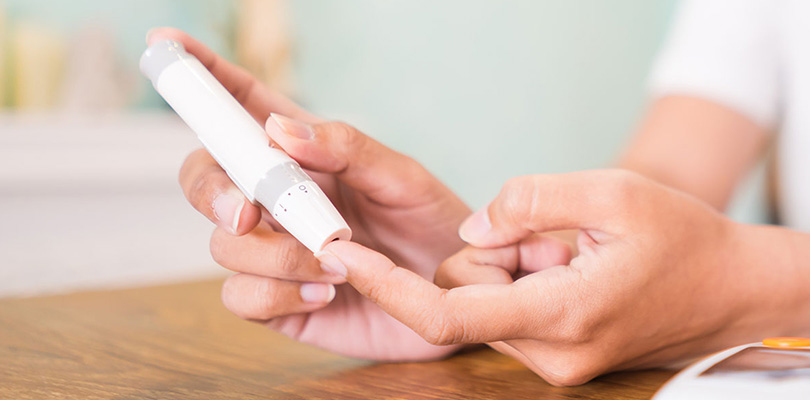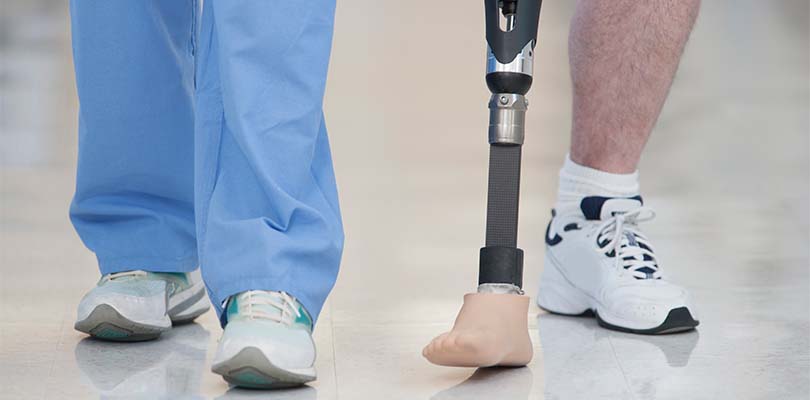Nerve Damage Treatment for Diabetics
Nerve damage, also known as neuropathy, is a widespread problem among diabetics. In this article, we discuss how diabetes causes nerve damage, common neuropathy symptoms and some possible nerve damage treatment options.
What Is Nerve Damage?
The scientific name for nerve damage is neuropathy. The most common type of nerve damage in diabetes is peripheral neuropathy. What this means is that the damage occurs in the peripheral nerves, or those outside the central nervous system. There are different types of peripheral neuropathy, classified according to which nerves are being affected:
- Sensory neuropathy: damage to the nerves that control sensations like touch, temperature changes and pain
- Motor neuropathy: damage to the nerves responsible for movement
- Autonomic neuropathy: damage to the nerves that control digestion, blood pressure and bladder function
- Focal neuropathy: damage to a single group of nerves. For example, carpal tunnel syndrome
- Proximal neuropathy: damage to nerves in the thighs, hips and buttocks
How Diabetes Can Cause Nerve Damage
People with type 1 and type 2 diabetes are at higher-than-average risk of developing nerve damage. This is because their bodies are unable to process sugar effectively. If the blood sugar remains too high for a sustained period, it can eventually damage the nerves, leading to neuropathy.
There are also other risk factors for nerve damage:
- High blood pressure
- High cholesterol
- Smoking
- Alcohol
- Kidney or liver disease
- Vitamin B deficiency
It is more likely to develop in people over the age of 40, or those who have had diabetes for a long time.
Common Symptoms of Nerve Damage
The symptoms of nerve damage will vary depending on which nerves are being affected. Sensory neuropathy is one of the most common types of nerve damage and can cause varying symptoms:
- Numbness
- Tingling
- Shooting, stabbing, or burning pain
- Insensitivity to hot or cold
- Reduced balance and coordination
The symptoms of motor neuropathy:
- Muscle weakness and wasting
- Loss of mobility
- Paralysis
Common symptoms of autonomic neuropathy:
- Digestive problems
- Low blood pressure
- Rapid heartbeat
- Excessive or lack of sweating
- Sexual dysfunction
- Bladder and bowel problems
The symptoms of neuropathy tend to affect the longest nerves first. Therefore, the first place that many people experience nerve damage is the feet. Eventually, it may affect nerves closer to the central nervous system, such as those of the hands.
In most cases, these symptoms can come on gradually over the course of several years. However, it is essential to see a doctor at the first signs of nerve damage. Receiving the right treatment early on can slow down the progression of the disease.
Diabetic leg pain is usually due to a condition known as peripheral neuropathy. Learn more about the causes, symptoms, and treatment options here.
Nerve Damage Treatment Methods
Unfortunately, regular painkillers like acetaminophen and aspirin do little to relieve the symptoms of neuropathy. However, there are several nerve damage treatment options that may help.
Blood Sugar Control
The best way to prevent nerve damage and slow its progression is by keeping your blood sugar under control. Diabetics should monitor their blood sugar regularly to ensure that it stays within a healthy range. It is also crucial to eat the right foods and take medication on time. Anyone who frequently suffers from high blood sugar should consult their physician to discuss their options.
Lifestyle Changes
Making some healthy lifestyle adjustments can help to keep blood sugar levels in check and reduce the risk of nerve damage. Some of the most important factors to consider include:
- Maintaining a healthy weight by eating well and exercising regularly
- Keeping blood pressure and cholesterol levels under control
- Reducing alcohol intake
- Not smoking
- Taking vitamin B supplements if necessary
Medication
Although over-the-counter painkillers are not usually effective for neuropathic pain, there are medications that can ease the symptoms of nerve damage.
Doctors sometimes prescribe antidepressants, such as amitriptyline (Elavil), nortriptyline (Pamelor), or desipramine (Norpramin). These drugs work by altering signals in the nervous system to relieve symptoms like pain.
Anticonvulsant medicines like gabapentin (Neurontin) and pregabalin (Lyrica) work in a similar way. However, both antidepressants and anticonvulsants can cause side effects, including dry mouth, drowsiness and weight gain.
Topical Creams
A treatment that may cause fewer side effects is capsaicin cream. It contains the chemical that makes chili peppers hot and works by blocking signals in damaged nerves. Side effects include skin irritation and burning.
Strong Painkillers
If other nerve damage treatments do not work, doctors may prescribe stronger painkillers like tramadol. However, these medications have a long list of side effects, including drowsiness, dizziness and nausea. There is also a high risk of overdose and addiction, so tramadol is usually a last resort. Specific medications are also available for other symptoms like bladder problems, digestive issues and sexual dysfunction.
Complementary Therapies
Some patients who experience nerve damage find relief with complementary therapies like acupuncture, massage, mindfulness, or yoga. Although there is limited clinical evidence to support their use, these treatments are generally safe and may be worth a try.
Diabetic Foot Care
One of the major complications of nerve damage is that a person may not notice wounds on their feet or legs.
Since people with diabetes may have problems with delayed healing, this wound can easily become infected. If the infection spreads, it may be necessary to amputate the affected limb.
Therefore, it is crucial that people with diabetes check their feet and legs for wounds regularly, especially if they suffer from nerve damage. Identifying problems and treating them promptly can prevent more serious complications later on.







